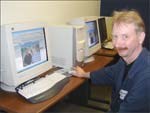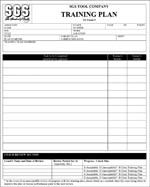Training For Now And The Future
Online learning tools are quickly becoming a standard for many shops looking to maintain a high level of continuing education while keeping expenses at a minimum.
#workforcedevelopment
In the business world, we all face a constant battle to perform faster for less money. As companies look to trim costs and save time, an item such as training, with an often overlooked benefit to the bottom line, has a tendency to fall by the wayside. However, with the impact software has had in streamlining production and reducing waste in other areas, it can help turn the tide in training as well and help return this key ingredient to successful shops around the country.
Virtually every company official would claim that his or her corporation’s most valuable asset is its people, but in recent years, the dedication to those employees has not been as apparent in regards to training. With the need to reduce costs across the board, companies have found it necessary to eliminate or greatly reduce the amount of time devoted to training, including the associated losses in production time and the high cost of travel that often go along with it.
Featured Content
According to Jack Schron, president of Tooling University (Cleveland, Ohio), only recently has there been an upswing in training as companies are beginning to block out as much as 2 to 3 percent of their budgets. Much of this increase in spending can be attributed to the greater availability of online training and other lean training methods designed to eliminate the need for many of the expensive requirements of traditional training. “The goal is to speed up the learning process while adding productivity enhancements that increase output, improve quality and lower scrap,” Mr. Schron says.
Timing is an important element in training as well. Often, new employees or new equipment make immediate training necessary, and arranging these learning opportunities is not always instantaneous. With online training, “just in time” is the norm. As soon as the need arises, the training is available. Students can simply log on and learn, and with Internet access, courses can be taken from any location at any time.
Online training also provides the means for students to learn at their own pace. Some students need to move more slowly than others, and being able to learn at a comfortable level adds to retention of the material. Even for those who do not retain information well, most programs allow students to return at any time to review courses that they have already completed.
Many online learning tools also offer a system for administration and reporting, so management personnel can view and keep track of what the employees are doing and help them set constructive goals. It is these administrative tools that allow companies to directly measure the success of both individuals and the program as a whole, applying these tools to such things as job bidding and employee promotion.
Applying What We Know
Tooling University, available through Production Machining Online, was created to address the shortage of skilled workers in an increasingly competitive global marketplace. The company views the root of these issues as a lack of employee knowledge and skills rather than a shortage of workers, and therefore, addresses some of the most critical skill and capability requirements of the manufacturing workforce.
Tooling U targets the specific needs of the manufacturing industry and vocational educational institutions, creating a continuous learning cycle for building key manufacturing skills and capabilities. The system uses pre-training diagnostic tools to assess a company’s training needs. Job-related class content is then used to train employees in a self-paced, interactive learning environment. Administrative tools and reports provide analysis of employees’ progress.
This program currently offers about 250 different courses (many offered in Spanish) covering the fundamentals of metalworking, including beginner, intermediate and advanced courses in metalcutting, workholding, CNC machining and controls, materials, inspection and quality and several other metalworking subjects. Specific courses include definitional-level classes such as Basics of the CNC Swiss-Type Lathe, The Mechanics of CNC, and Intro to Materials; intermediate classes such as Mechanical Properties of Metal, Cutting Variables, and Tool Geometry; and advanced classes such as Canned Cycles, Optimizing Insert Life, and Speed and Feed Selection. The entire course list is available from the site’s home page, and visitors can take a trial class at no cost.
The company is continually working with instructors and industry experts to develop more courses to raise the level of knowledge in the industry and boost operational performance. These high-impact training programs are designed to reduce costs and improve profitability. Measurable results can be seen in reduced scrap and rework, decreased tooling costs and shorter setup times. According to Tom Barrett, vice president of sales, some companies are reporting as much as a 7 percent increase in productivity since the implementation of online training.
Getting Started
A company can purchase a Tooling U subscription for a flat annual fee for as many individuals as it would like. Each subscriber, then, has unlimited access to all courses for that year. Once students are registered, the Tooling U assessment tests are a helpful first step in developing a training program that meets the exact needs of the individual students or trainees. Online assessments identify skills gaps of the students and clarify the specific training that each student needs. When a student completes a test, the administrator is sent an e-mail with a link to a page that identifies the skills gap and lists the specific class recommendations for the individual.
When building the curriculum, a company can customize the course content, requiring that employees complete mandatory classes or classes in a particular order, take pretests or achieve required performance levels before receiving credit for one class and continuing to the next. Additional customization is also available for companies that wish to incorporate existing training materials into the online curriculum.
Testing methodology can be designed to meet the needs of an individual or company. Individuals can have access to online tests at any time, or for a more supervised testing environment, tests can be printed and administered by a supervisor. Once complete, administrators can assess the knowledge levels of the individuals and determine areas where capabilities are in need of improvement.
Logging into the administration center allows a company to track the performance of student accounts. Numerous administrative tools are available, including the ability to register new students, set and track goals, set and change student permissions, add classes to student schedules, send and receive messages and run detailed performance reports.
For a student to log on to Tooling U, he or she must have a subscription ID assigned by an administrator. Permissions allow an administrator to control student activity, including whether students register for classes or whether that function is controlled by the administrator. Administrators set the minimum passing test score or cut score and determine whether students can retake tests, whether they see their answers to tests they have completed, whether they can take the final exam before completing the class and much more. The administrator can also re-register students for classes. The administrator provides students with either hard-copy or e-mail instructions of their registration process. When a student is ready to begin training, the administrator prints out a hard copy or e-mails the registration instructions to the student.
Because some individuals may not have an e-mail address and only have access to a computer while in training, Tooling U provides an e-mail box for each subscriber and administration account. Administrators and students use the My Messages tab to send and receive messages.
The administration center provides an impressive amount of information. Clicking on a student’s name provides a detailed report of the student’s activities. Administrators can monitor login activity and class status, including time spent in each class and completion status. Administrators can track student test scores and link back to recaps of every test, including every question a student has asked in a forum, and determine how a student is progressing in any of the class goals that have been set.
Group reports allow an administrator to track the progress of all of the students based on a range of criteria. Reports are available as excel documents, graphs and Web pages. Administrators can generate student reports based on time spent in class, completed classes, login history, test scores, cut scores, class goals and progress of schedules. Comprehensive reports are also available, showing all students, schedules, time in class and both pretest and final exam scores.
On Course
Tooling U classes have targeted learning objectives and include detailed illustrations and photos, full-motion video and an optional audio presentation of the lesson text. Definitions of key terms pop up when a user hovers the cursor over the word. Students have access to other learning tools as well, including an article archive, chat room sessions with industry experts and industrial resources such as charts, formulas, conversion factors, online calculators and an industrial dictionary.
When a student logs in, he or she is immediately presented the schedule of classes that the administrator has selected. The student can select the appropriate course from the list and begin. Each class is introduced with the learning objectives and course outline to familiarize the student with the material that will be covered. Then as many as 20 lessons are presented sequentially to progressively bring the student up to speed. Because the courses follow a common presentation style, they allow quicker understanding by the student and better retention of the subject matter.
If a student has a question about anything in the class, he or she can click on the Professor icon at the top of each page of the lesson. The student can then post a question to other students in a forum.
Upon completion of the class, the student takes the final exam to validate how well he or she has mastered the material. After the exam, the student can review the questions and his or her answers, with correct answers provided where the incorrect answer was selected. Explanations of each question are provided along with links back to the relevant lessons. Students can also return to the class at any point in the future to review the material covered.
My Personal Experience
When I began writing for Production Machining, I wanted to be sure I had a solid refresher. I began reading. I read a lot, from back issues of our magazine to text books. One of the best tools I found, though, was Tooling U. Through our company account, I logged on and began taking courses. I worked through beginner-level courses and on up through the series.
Some training exercises seem to work better than others. Tooling U, because of its systematic presentation methods and comprehensive subject matter, can bring students to the level of knowledge expected by supervisors. Organizations can feel good about the program as well because managers can help employees set goals and observe their progress every step of the way.
RELATED CONTENT
-
New Line of Swiss-Types for Job Shops Eyeing High-Production Work
Mazak now offers the Syncrex line of Swiss-type CNC lathes — its first — targeting machine shops getting into higher volume production of complex parts.
-
Inventory Control Systems For The Shop
An ongoing effort towards more efficient operations drove this shop to take a closer look at indirect material usage, subsequently leading to implementation of a new system for tracking toolroom inventory.
-
Communication: Motivating Employees To Work In The Best Interest Of The Business
Fair treatment is all most employees ask of their employers. Showing both family and non-family employees what is fair and having open lanes of communication allow for a healthy exchange of what constitutes equitable treatment. Effective communication between management and employees on important issues, such as compensation and firm strategy, needs to take place to maintain a motivated and enthusiastic workforce.











